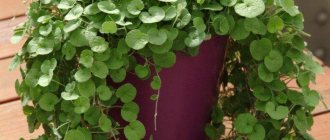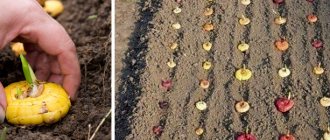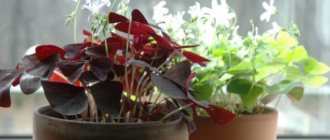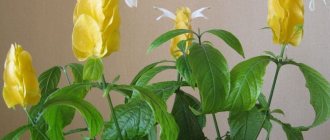The evergreen herbaceous perennial plant Dichondra is part of the Convolvulaceae family. Plants such as calistegia, morning glory and bindweed are considered related to dichondra. The name of this plant is derived from 2 Greek words translated as “two grains”, which is associated with the appearance of the dichondra fruits, which look like a two-chambered capsule.
This genus includes 10 species; under natural conditions they can be found in the humid regions of the subtropics and tropics of New Zealand, America, Australia and East Asia. Flower growers began cultivating this flower quite recently, but at the same time, designers have learned to make beautiful compositions with its help. That is why in 2004, at an exhibition held in Moscow, dichondra received a silver medal.
Brief description of cultivation
- Bloom . Dichondra is cultivated as an ornamental foliage plant.
- Landing . Seeds for seedlings are sown in January or February, and young plants are planted in open soil from the last days of May to the second half of June.
- Illumination . Grows well in sunny areas, in diffused light, in shady areas and in shade. Varieties with silver foliage are more light-loving.
- Soil . Loams with good drainage and a pH of 6.6–8.0 are ideal for growing crops.
- Watering . Moisten the soil moderately but systematically, and do this in the evening to avoid burns on the leaf blades.
- Air humidity . During the hot, dry period, it is recommended to moisten the foliage in the evening.
- Fertilizer . During the growing season, fertilizing is carried out once every 15 days; for this purpose, complex mineral fertilizer with a high content of potassium and nitrogen is used.
- Trimming and pinching . To make the plant more lush, at the stage of formation of the fourth pair of leaf blades, its stems are pinched. Also, regularly trim the stems every 7 days as they grow.
- Reproduction . By seeds, layering and cuttings.
- Pests . Whiteflies, flea beetles, nematodes and aphids.
- Diseases . It is highly resistant to diseases.
Planting a flower for seedlings depending on the region
The climatic conditions of the regions differ from each other and make their own adjustments to the exact timing of sowing ornamental plants.
In the southern regions, spring comes earlier and allows gardeners to plant seedlings in open ground or in flowerpots already in mid-spring, when warm weather sets in. In these parts, seedlings can be sown immediately after the New Year.
In Central Russia, sowing dates move a little closer, so they are planted as usual in mid-January.
The harsh climate of the northern regions and the Urals does not allow planting seeds early, but you should not delay the start of cultivation either, otherwise the green mass will not gain the required volume. In these regions, flowers are usually planted in late January - early February.
Features of the ampelous dichondra
Dichondra is a creeping evergreen plant that forms a dense carpet on the surface of the earth. The plant's root system is superficial. The stems reach a height of no more than 15 centimeters, but their length varies from 100 to 150 centimeters. Branched creeping shoots are able to quickly take root thanks to the superficial roots that form in the internodes. Flowering is observed in May–August; during this period, flowers open on the plant that do not have high decorative value; they reach from 0.2 to 0.3 cm in diameter and are colored purple, pale green and light yellow. Pollination of flowers occurs thanks to small insects. The shoots are decorated with lush foliage, its shape is round (similar to a coin), and its diameter can reach 5–25 mm.
Ampelous dichondra is very popular among gardeners. In regions with mild and warm winters, it is cultivated as a perennial, and where it is very cold in winter, it is grown as an annual. In the warm season, indoor dichondra is taken out onto the terrace or balcony, and in the winter it is brought into the house.
general information
The evergreen perennial is a close relative of morning glory and other bindweeds. Its long, tenacious shoots grow up to 1.5 m and form a continuous carpet on any surface. In addition, dichondra also blooms in summer.
The root system matches the above-ground part - superficial and creeping. Dichondra quickly grows in breadth because its shoots self-root during growth. The small leaves resemble coins with a diameter of 0.5 to 2.5 cm.
Photo: sad6sotok.ru
Growing dichondra from seeds
Sowing
If dichondra is grown in the garden as an annual, then it can be propagated by seeds, cuttings (rooting is carried out in the summer) and layering. If your site does not yet have this plant, then for primary cultivation they use the generative (seed) method, and you can grow the flower through seedlings, or you can sow the seeds directly into open ground.
Sowing seeds for seedlings is carried out in the middle of the winter period, or more precisely, in January or February. Before sowing, the seed material is immersed overnight in water, to which a growth stimulating agent is first added. The container is filled with pre-disinfected peat soil substrate intended for growing seedlings, which is spilled with sodium humate. The seeds are buried in the soil mixture no more than 0.8 cm. It is recommended to sow the seeds in small pots, with 2 or 3 seeds placed in each of them. Cover the top of the container with glass (film), and do not forget to leave a small hole for ventilation. Crops are transferred to a warm (22 to 24 degrees) place with bright, diffused light.
Growing seedlings
If everything is done correctly, then the first seedlings may appear just 7 days after sowing. The emerging seedlings are characterized by extremely slow growth, so the shelter from the container is removed only after they have become stronger.
Do not forget to systematically water the young plants, and also carefully loosen the surface of the soil mixture. Remember that if the plants do not have enough light, then they can become very elongated. A small amount of a growth stimulating agent must be systematically added to the water intended for irrigation. Picking of seedlings is carried out during the development of 3 or 4 true leaf blades. If you are growing the plant as a hanging plant, then you need to transplant it immediately into a hanging basket or flowerpot. But if you need seedlings for planting in open ground, in this case the picking is carried out in larger pots. Before planting seedlings in the garden, they should be hardened off.
"Silver waterfall" in your garden. Dichondra - growing from seeds
Care errors and their elimination
Frequently encountered problems when growing dichondra and their solutions:
| Problem | Causes | Solution |
| Stretching shoots, shredding leaves | Lack of lighting | Move the plant to a brighter place |
| Dark spots on shoots and leaves | Excess moisture in the soil | Reduce the number of waterings, prevent stagnation of moisture and acidification of the soil |
| Brown spots on leaves | Sunburn | Move the flowerpot under bright, diffused light |
Planting dichondra in open ground
What time to plant
In regions with warm and mild climates, dichondra is used to create an alternative lawn. This is possible due to the fact that it is resistant to frost and also to trampling. The ampelous dichondra is transplanted into the garden only after 1.5–2 months have passed after the seedlings appear. In the northern regions, dichondra seedlings are planted around the first half of June, and in the southern regions - in May. This flower grows well in sunny areas and in shade. But it should be taken into account that the variety with silver foliage is more light-loving. Dichondra does not have any special requirements for soil composition, but it grows best in well-drained loamy soil with a pH of 6.6–8.0.
Landing rules
If you plan to grow dichondra as a ground cover plant, then you need to remember that it is characterized by extremely slow growth. That is why, when planting in the ground, a distance of 10 to 15 centimeters must be maintained between the bushes. The depth of the planting holes should be such that the root system of the plant, taken together with a lump of earth, can be placed in them. Carefully transfer the seedlings into the holes and fill them with soil, compact its surface and water generously.
Growing conditions - soil, planting site
Dichondra is not difficult to grow. Due to its origin, it makes very specific requirements. The silver and creeping species have the same growing requirements. Both species grow best in the sun; they can be grown in partial shade.
Soil for dichondra is needed with the following characteristics:
- fertile;
- must be permeable (sand can be added to the flower soil);
- moderately humid.
The most important condition is soil permeability. The plant does not like it when there is excess water at the roots; the pot must have drainage made of expanded clay and pebbles.
Caring for dichondra in the garden
Watering
If dichondra is cared for correctly, then when grown in the garden it will retain its high decorative value for 5–7 years. Although this crop is drought-resistant, watering must be systematic. However, liquid should not be allowed to stagnate in the soil. To prevent burns from appearing on the surface of the leaf plates, it is recommended to water this flower in the evening. On hot days, try to moisturize the bushes in the evening, as dichondra reacts positively to this procedure.
Top dressing
In order for dichondra to be as effective as possible, throughout the growing season, systematically feed it once every 15 days. To do this, use a mineral complex fertilizer with a high content of nitrogen and potassium.
Trimming
When the eighth leaf plate of the bush has formed, it is recommended to pinch it. Then, as the shoots grow and branch, prune. As a rule, during the summer, on average, one haircut is performed every 15 days.
You need to pull out weeds carefully, because the root system of dichondra is superficial and located at a shallow depth, so it can be very easily injured.
How to grow dichondra
Possible problems
Dichondra is undemanding to care . An unpretentious plant copes well with difficulties. It is recommended to regularly spray the stems with special compounds throughout the growing season. This manipulation is justified in relation to pest control. Fleas and nematodes can cause significant damage to the bush, and fighting them will require more effort and time than prevention.
Worth knowing! Adding fluff lime to the soil has worked well. For the same purpose, before planting in the garden, plants are sprayed with a solution of copper sulfate.
Dichondra care at home
It is not difficult to grow dichondra at home, but you need to remember its characteristics. They care for it in almost the same way as for other ampelous decorative foliage plants, for example, creeping ficus, asparagus, zebra, chlorophytum, rooting ficus or saxifrage.
Illumination
The amount of light a plant needs depends on the color of its foliage, for example, varieties with silver leaves need a lot of light, and green-leaved varieties can grow in a sunny or shaded place, or even in the shade.
Temperature
Throughout the year, in the room where the flower is located, the temperature should be between 18 and 25 degrees. However, if in winter it is in a room that is not heated, make sure that it is not colder than 10 degrees, otherwise the dichondra may die. If the room is always hot, then this has an extremely negative effect on the growth and development of the bush.
Air humidity
This flower is able to grow normally at low air humidity. However, if you moisten it every day, the green mass will increase by up to 25 percent. If you spray dichondra regularly in the morning and evening, then the green mass will grow 2 times faster. If in winter the flower is warm (above 18 degrees), then special attention should be paid to moisturizing the foliage.
Watering
Water the flower abundantly, but make sure that there is no stagnation of liquid in the soil mixture. In this regard, it is necessary to make a good drainage layer at the bottom of the pot. In the event that you cannot water the flower for a long time, then it can survive for some time even if the earthen clod is completely dry. Once the bush is watered, it will recover very quickly.
Fertilizer
Dichondra should be fed once every 15 days from April to September. To do this, use fertilizer for decorative deciduous indoor plants, for example, Ideal. And in order to accelerate the growth of deciduous mass, the flower can still be fed with Agricola once every 7 days. During cool wintering there is no need to feed the plant.
Trimming
In order for the bush to be dense, it will require regular pruning and pinching. When preparing the dichondra for winter, it should be trimmed. To make it more luxuriant, systematically pinch the ends of the stems, and after they have become very elongated, they are cut off. In cultivation, shoots can reach a length of about 200 cm, and if the climate is warm, then up to 600 cm.
Landscape designers often use dichondra to create an imitation of a “running stream” in a garden plot; it looks very unusual and beautiful. After the falling shoots reach the soil surface, they quickly take root, and the hanging plant becomes a ground cover. Decide for yourself whether to shorten the stems regularly or whether they will grow freely, but if you do not pinch the ends of the shoots, then the bush will not be so lush and spectacular.
Appropriate place
This flower grows and develops well both at home and in open ground. The surface roots formed in the internodes of the shoots allow the vines to take root very quickly, due to which the bush forms a continuous carpet of silver or green color, which does not lose its color even in winter.
A flower grown as an hanging plant has shoots flowing down like a green or silver waterfall. A basket or flower pot with a flower can be hung both in the living room and on the veranda, loggia, terrace or balconies.
Diseases and pests
Dichondra is very resistant to all pests and diseases. The fact is that it is essentially a weed, and if you care for it properly, then there will be no problems with it. But nematodes, which are microscopic worms that develop in conditions of high humidity, can still harm the plant. Due to nematodes, the plant experiences mutations that cause its death. At the same time, nematodes can settle both on those dichondras that grow in open ground and on those grown indoors. It is very difficult to get rid of nematodes; therefore, it is recommended to destroy the infected bush, as well as the soil in which it grows.
Much less often, aphids, whiteflies or flea beetles settle on the plant. In order to get rid of these insects, acaricidal drugs are used; in addition, it is recommended to adhere to preventive measures:
- the surface of the soil around the bushes cannot be covered with mulch, and pull out weeds only with your hands;
- if the bushes have become a dense carpet, then it is necessary to reduce the frequency of watering;
- Make sure there is not too much nitrogen in the soil.
Pest and disease control
By its nature, dichondra is an ordinary weed, so it is not affected by pests and diseases. The only parasite that poses a serious threat is nematodes, which are difficult to notice and useless to fight. If the problem has already been discovered, such plants need to be removed quickly, the soil should be disinfected and nothing should be planted in this place in the near future.
Photo: 1poin.com
Gladioli (50 photos): types, proper care and cultivation
Reproduction methods
How to grow dichondra from seeds is described in great detail above. This plant can also be propagated by rooted layering and cuttings. Vegetative propagation methods are easier and more effective than seed propagation. When the vines are pinched or trimmed, many stem apical segments remain that can be used as cuttings. They take root very quickly. In winter, it is recommended to grow rooted cuttings indoors, and with the onset of spring they are transplanted to a permanent place.
It is much easier to propagate dichondra by layering. The fact is that the stems, in contact with the surface of the earth, take root themselves. Separate the resulting cuttings when you need them and plant them in a new location.
I propagate Dichondra by layering
Transfer
Bacopa ampelous - growing and care at home
You need to replant the plant to a permanent place in the evening. During the night, the root system adapts to new conditions, which will increase the survival rate of the bush.
Before planting, you need to form holes at a distance of 10 cm from each other. A peat mixture is placed at the bottom of each hole. And only after this, with care, so as not to damage the delicate roots, is the bush planted. The hole is filled with earth and watered well with warm, settled water.
Planting dichondra seedlings
Wintering of perennial dichondra
In those regions where winters are warm and mild, perennial dichondra can overwinter in open ground. To do this, the bush is covered with a layer of soil, and the top is covered with a film, which is covered with fallen leaves. In regions with frosty winters, the bush is transferred to a greenhouse with subtropical and tropical crops; it can also be placed on a glazed balcony, enclosed veranda or loggia. Dichondra should be in a well-lit room, where the air temperature should be from 11 to 15 degrees. During this period, the flower is not fed, but watered rarely and with a small amount of water.
A plant grown in open ground must be dug up in the fall and, together with a lump of earth, transferred to the basement, where it will remain in suspended animation until spring. In early spring, cut off the stems with root shoots from the mother plant, while the remaining root system is transplanted into the garden.
Dichondra Silver Falls. Wintering
What plants does it go with?
When grown at home, on the balcony or in the garden, silver waterfall is combined with hanging and erect perennials. Looks good close to culture:
- fuchsia;
- petunia;
- begonia;
- coniferous plants;
- sage;
- eustoma.
Using perennials, you can beautifully decorate the facade of a house or fence, raised borders in the garden and gazebos. In pots, dichondra is hung on arches, creating a silver-green frame for them.
In the garden, ampelous dichondra is often used as a ground cover on slopes and alpine hills.
Main types and varieties
In natural conditions, you can meet at least 10 species of dichondra. However, only one species is grown in culture - Dichondra repens, or Dichondra argentea, which is a herbaceous evergreen plant (a detailed description of the species is given above).
This species has a couple of varieties, namely, silver dichondra and green dichondra, which are very popular in culture:
Emerald Falls
The shoots are decorated with round green leaf plates. A bush growing in a sunny place has smaller foliage than a dichondra plant growing in a shaded area.
What does dichondra look like, photo of a flower
Dichondra is a perennial plant native to tropical and subtropical forests.
The roots are often located very close to the surface of the earth (and often on the surface itself) and are well adapted to weather changes.
From a low bush, stems grow from 1 to 3 meters long, depending on the variety and place of growth.
Dichondra blooms throughout the summer with small flowers of different shades. Decorative round leaves can be painted in rich silver or green colors.
Watering
When growing dichondra, the seed bed should be moist but not soggy. The seed sprouts will die as soon as they dry out, so it usually takes several waterings 3-5 times a day to keep the soil moist.
Use a mist to avoid washing away soil and seeds. Proper watering is the most difficult and important step when growing any type of lawn.
In warm weather, the seeds will germinate in 1-2 weeks. The first leaves that appear will be long and narrow and will not look like true dichondra leaves. A week after most of the seedlings have grown, allow the soil surface to partially dry out between sprays.
Gradually increase the amount of watering each time you water, gradually decreasing the frequency. When you water, you need to water deeply, but not often - give dichondra flowers a good soak because they have a deep root system.
Watering too frequently will cause an invasion of diseases and weeds.
Reproduction by layering and cuttings
In summer, dichondra bushes easily reproduce by layering. To do this, loosen the soil around the plant well, select a strong long shoot and dig it in in several places, pouring it with a root formation stimulator. To preserve moisture, it is advisable to cover the layerings with film or non-woven material. Very soon sprouts with the same varietal characteristics will appear. When 4 true leaves develop, the plants are replanted.
Another option is propagation by cuttings. In September, several well-developed stems are cut from the main bush and cuttings with 3-4 internodes are cut from them. The cuttings are planted in individual pots with a nutrient substrate, watered abundantly, and covered with film or cut bottles. With the onset of cold weather, pots with cuttings are brought into the house and the soil is constantly kept moist.
Photo of dichondra
Plant characteristics
“Silver Falls” grows quite quickly, gaining green mass in just 20-30 days. It is distinguished by a cascade growth method, which creates the impression of a waterfall. The shoots are densely filled with green-silver foliage.
Characteristics:
- superficial root system;
- shoots: height – 12-15 cm, length – 1-8 m;
- stems: branched type that produces roots between the nodes;
- leaves: coin-shaped, round, multiple;
- foliage color: silver-green, characterized by silky pubescence;
- Flower blooming period is May-August;
- color of flowers - lilac;
- compatibility: petunia, verbena, balsam, lobelia.
You can create amazing shapes from dichondra by properly directing the lashes. It could be a waterfall, stream, cascade, etc.
Sowing seeds
When growing from seeds, you should scatter or sow at the rate of 450 grams per 46–92 square meters. meters. A higher concentration will give the rack density.
Rake the seeds to lightly cover them. A very shallow covering of peat moss or similar organic matter will help retain moisture until your seeds germinate.
When to plant dichondra seedlings in 2022 according to the lunar calendar
For a long time, flower growers and gardeners, before starting work, turn to the advice of the lunar calendar compiled by astrologers.
Favorable days for planting dichondra in 2022 according to the lunar calendar
In order for seedlings to become strong, they must form a healthy root system and grow green mass. The most suitable phase for sowing seeds for seedlings is the waxing moon phase.
The table below shows recommended planting dates.
| Month | When to plant |
| January | 4, 5, 6, 7, 8, 9, 10, 11, 12, 13, 14, 15 |
| February | 2, 3, 4, 5, 6, 7, 8, 9, 10, 11, 12, 13, 14, 15 |
| March | 3, 4, 5, 6, 7, 8, 9, 10, 11, 12, 13, 14, 15, 16, 17 |
When to plant dichondra seedlings in 2022 according to the lunar calendar is not worth it
According to the observations of astrologers, the following numbers will be unfavorable days for planting in 2022:
| Month | When not to sow |
| January | 1, 2, 3, 16, 17, 18, 19, 21, 22, 25, 26, 30, 31 |
| February | 1, 16 |
| March | 2, 18 |
Care
For the dichondra silver waterfall plant, the cultivation and care conditions are very simple and accessible to everyone, since it is unpretentious. But still, some points need to be known in order to fully grow the plant.
Humidity
Dichondra does not require high levels of air humidity, although, being a resident of humid regions, it tolerates high levels of humidity and spraying well.
Lighting
The dichondra variety with silver leaves can grow in the sun and in the shade, but it feels more comfortable in the sun or partial shade.
Temperature
The optimal air temperature for this dichondra variety is 18-24° C. If the temperature is lowered to 10° C, the plant may die.
For Silver Falls, abundant and frequent watering is better, but stagnation of moisture at the rhizome can be detrimental to the vine. Therefore, in the flowerpot where it is planted, high-quality drainage is required. The plant can tolerate short-term drought, but only short-term.
Top dressing
From mid-spring until autumn, Silver Waterfall needs to be fed with complex fertilizers intended for decorative deciduous indoor flowers every two weeks. From autumn to spring, the plant does not need to be fertilized. After fertilizing, it is necessary to wash the leaves and stems of the vine with fertilizers to avoid burns. But it is better to alternate nitrogen fertilizers with mineral ones when feeding.
Experienced gardeners advise using long-term fertilizer when replanting. Nitrogen fertilizers are ideal for these plants.
Priming
Dichondra is not picky about soils, but it is more comfortable on loams. The recommended pH level for “Silver Falls” is 6.6 – 8. Universal soil, which is sold in stores for decorative indoor foliage flowers, is also suitable for it.
Trimming
The flower needs regular pruning to become a branchy and beautiful vine. It is pinched and trimmed to give it fullness.
Preparing for winter
Dichondra grows slowly, so experienced gardeners do not recommend sowing seeds every year. It is better to try to preserve the plant in winter. Covering with fallen leaves or agricultural canvas in a frosty winter climate will not work. A heat-loving plant can die in severe frosts. It is better to bring it indoors for the winter, and with the arrival of spring, propagate it in one of the following ways. Dichondra should be placed on the brightest window in the building, as she loves light. The plant also needs to have good soil drainage. It is better to limit watering.
How to grow seedlings?
“Silver waterfall” seedlings are obtained using 2 methods:
- Cuttings. Up to 7 cuttings are prepared, which are placed in a container with water for rooting. After the roots have formed, transplantation into the ground is carried out.
- Germination of seeds. Planting material is introduced into containers with soil, and after 4 months the seedlings are transferred to the ground.
Landing dates
It is best to grow seedlings from seed. Since the bush is formed over 4 months, sowing of seed material begins from January 15 to March.
The specific period depends on climatic conditions: in the Southern regions, sowing begins early (in January), in Northern latitudes - closer to March.
Selection of container and soil
To grow dichondra, containers are used that must be filled with earthen mixture. To do this, take soil and fine sand in equal proportions.
Seed preparation
To speed up the germination process and improve germination, prepare seed material. What can be done:
- use growth stimulants (Epin, etc.);
- soak in aloe juice;
- soak in hydrogen peroxide (1 tbsp per glass of water).
The soaking time for any solution is 50-60 minutes. Immediately after this, the planting material is planted.
Today you can find seeds on sale in granular form. In this case, soaking is not required.
Landing rules
Planting seeds for seedlings is carried out as follows:
- make 5 mm indentations in a container filled with soil mixture;
- introduce seeds;
- sprinkle a small layer of sand on top;
- use a spray bottle to irrigate the sand surface;
- cover the container with film or glass.
Peculiarities:
- before emergence of seedlings, the temperature regime is maintained at 24-25 degrees;
- the greenhouse effect is eliminated, so direct sunlight should not fall on the boxes;
- the first shoots form after 10 days;
- the cover is removed after the first shoots appear, after which the container can be moved to the windowsill on the sunny side.
Crop care
Dichondra grows slowly, so the first leaves appear only after one and a half to two months. During this period, it is necessary to pick the seedlings. That is, plant them in a more massive container. To do this, use boxes, flower pots and the like.
Gardeners most often deepen the subcotyledon a little, as aerial roots are actively developing. At the same time, the mustache also grows. In order for crops to grow faster, they are provided with a sufficient amount of light for 15 hours - additionally, phyto-, fluorescent lamps and the like are used.
At the beginning of development, the stems are actively growing, but they are still too weak. Therefore, it is necessary to stop their growth. To do this, add as loose soil as possible to the surface of the soil. Please note that the trunks break easily, so you need to add soil using a teaspoon and a toothpick, evenly distributing the soil throughout the container.
Seedling care
Rules of care:
- When the seedlings have 3 full leaves, fertilizer is required. Nitrogen fertilizers are used for these purposes. Dosage is 3 times less than for an adult plant.
- To make the foliage thicker, the ends are pinched. This is done at a distance of 10 to 15 cm along the stem as it grows.
- In order for the plant to quickly adapt to outdoor conditions, hardening is carried out. Namely, they take containers with seedlings out onto the balcony, loggia or street. Initially, an hour is enough, but every day the time spent in natural conditions is gradually increased.
- Be sure to monitor the soil moisture - it should not get wet or dry out.
How to plant and grow dichondra seedlings is described in detail in the following video:
Is it possible to propagate dichondra by cuttings or layering?
Not only is it possible, but it is also necessary. This is especially true for ampelous dichondra. Pruning and pinching stimulate the vegetative system to develop and grow. And cut cuttings take root easily and quite quickly. It is better to cut the stem at an oblique angle: the larger the cut area, the more abundant and stronger the root system. Add a root stimulator to a container with water - this will significantly speed up the process.
Reproduction by layering is another easy way to propagate the California beauty. Carefully pin the lash near the internode and cover the area with soil. After a new shoot appears from the bud, the mother stem can be carefully cut off. It is better to sprinkle the cut area with activated carbon powder.











